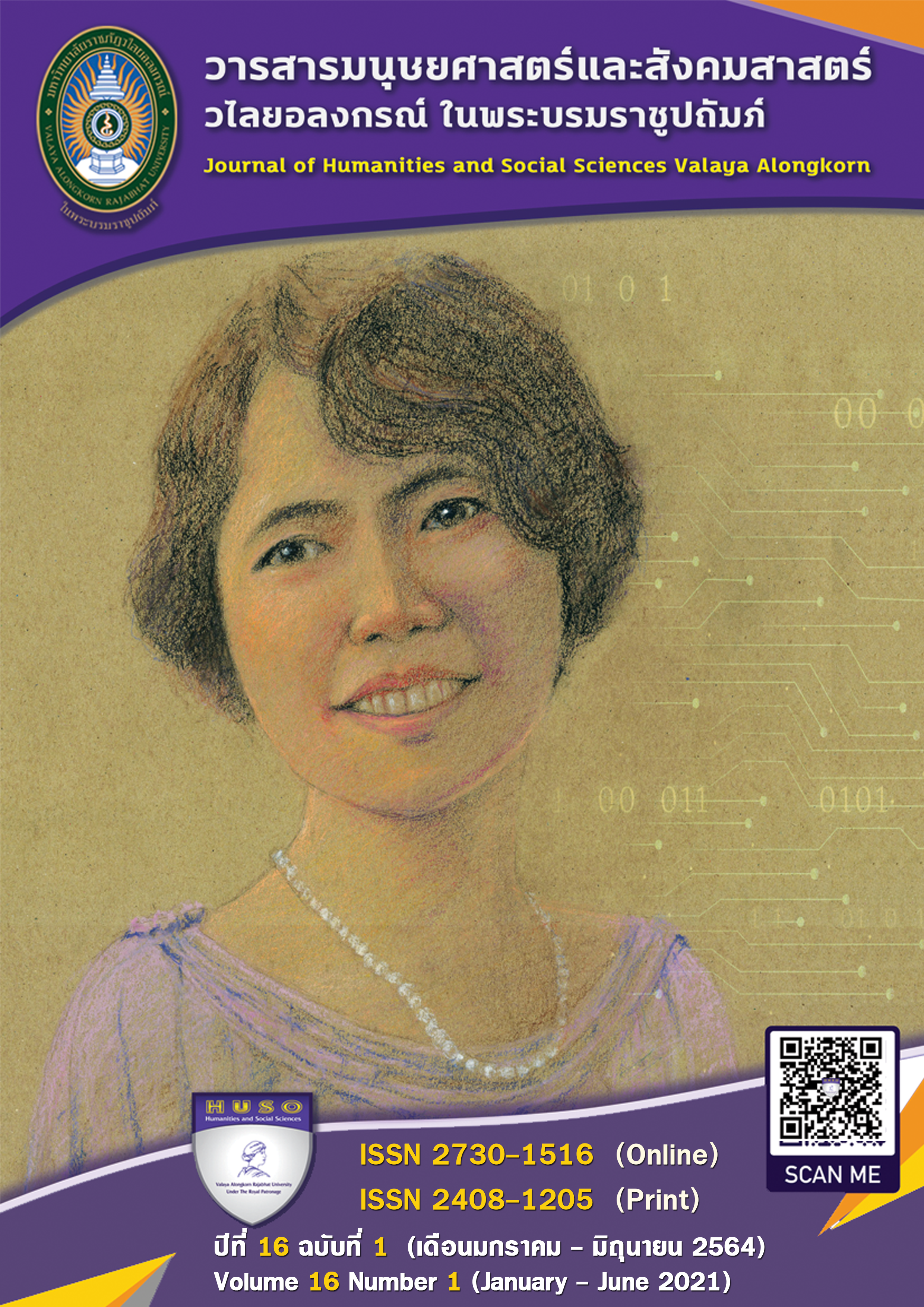DECISION MAKING FOR CHOOSING BALLET SCHOOL FOR CHILDREN
Main Article Content
Abstract
This research aimed to study the marketing mix factors affecting parents’ decision making process in sending their children to a ballet school in Chonburi province. The study of decision making for children to choose ballet in Chonburi province Conclusion Marketing mix factors (7P’s) Product Price Distribution Channels Marketing Promotion Personnel the results of the regression test show that the marketing mix (7P's) influences the decision making process of parents in sending their children to school. Ballet teaching in Chonburi as for the different personal factors affecting parents' decisions in sending their children to a ballet school in Chonburi, which is different. According to ANOVA statistical test revealed that personal factors in terms of sex, age, education, occupation, and income were different, which not affected parents’ decision making to send their children to a ballet school in Chonburi.
Article Details

This work is licensed under a Creative Commons Attribution-NonCommercial-NoDerivatives 4.0 International License.
ลิขสิทธิ์บทความวิจัยที่ได้รับการตีพิมพ์เผยแพร่ในวารสารมนุษยศาสตร์และสังคมศาสตร์ วไลยอลงกรณ์ ในพระบรมราชูปถัมภ์ ถือเป็นกรรมสิทธิ์ของคณะมนุษยศาสตร์และสังคมศาสตร์ มหาวิทยาลัยราชภัฏวไลยอลงกรณ์ ในพระบรมราชูปถัมภ์ ห้ามนำข้อความทั้งหมดหรือบางส่วนไปพิมพ์ซ้ำ เว้นแต่จะได้รับอนุญาตจากมหาวิทยาลัยเป็นลายลักษณ์อักษร
ความรับผิดชอบ เนื้อหาต้นฉบับที่ปรากฏในวารสารมนุษยศาสตร์และสังคมศาสตร์ วไลยอลงกรณ์ ในพระบรมราชูปถัมภ์ เป็นความรับผิดชอบของผู้นิพนธ์บทความหรือผู้เขียนเอง ทั้งนี้ไม่รวมความผิดพลาดอันเกิดจากเทคนิคการพิมพ์
References
Burgman M (2005). Risks and Decisions for Conservation and Environmental Management (Cambridge Univ Press, Cambridge, UK).
Bertsekas, D.P (1997) Nonlinear Programming, Journal of the Operational Research Society, 48:3, 334-334, DOI:
1057/palgrave.jors.2600425.
Break-even(2003) analysis revisited: the need to adjust for profitability, the collection rate and autonomous income. (2003).
Health Services Management Research, 16(3), 194–202. https://doi.org/10.1258/095148403322167951.
Chandon, P., Hutchinson, J. W., Bradlow, E. T., & Young, S. H. (2009). Does In-Store Marketing Work? Effects of the Number and Position
of Shelf Facings on Brand Attention and Evaluation at the Point of Purchase. Journal of Marketing, 73(6), 1–17.
https://doi.org/10.1509/jmkg.73.6.1
Ecker, U. K. H., Lewandowsky, S., & Apai, J. (2011). Terrorists brought down the plane!—No, actually it was a technical fault: Processing
corrections of emotive information. Quarterly Journal of Experimental Psychology, 64(2), 283–310.
https://doi.org/10.1080/17470218.2010.497927.
Faigenbaum, A.D .(2001). Strength Training and Children's Health, Journal of Physical Education, Recreation & Dance, 72 (3) 24-30, DOI:
1080/07303084.2001.10605847.
Fritzsche, D.J., Becker, H. Ethical behavior of marketing managers. J Bus Ethics 2, 291–299 (1983). https://doi.org/10.1007/BF00383187.
Fairbank, J. (1969). Assignment for the '70's. The American Historical Review, 74(3), 861-879. doi:10.2307/1873126.
Gillaspy, E.B .(2013). Paris in June: CORPS de Ballet International Marks Fifteen Years, Dance Chronicle, 36(1) 113-117, DOI:
1080/01472526.2013.756364. Grönroos, C. (1982), "An Applied Service Marketing Theory", European Journal of Marketing,16 (7)
-41. https://doi.org/10.1108/EUM0000000004859.
Harris, L. and Rae, A. (2009), "Social networks: the future of marketing for small business", Journal of Business Strategy, Vol. 30 No. 5,
pp. 24-31.
Hale, W.K (1980) "Frequency assignment: Theory and applications," in Proceedings of the IEEE, 68,(12)1497-1514, doi:
1109/PROC.1980.11899.
Kane E.W. (2006) “No Way My Boys Are Going to Be Like That!”: Parents’ Responses to Children’s Gender Nonconformity.
Gender & Society.;20(2):149-176.doi:10.1177/0891243205284276.
Keun, L.L & Hunt, P.G .(2006). Creative dance: Singapore children's creative thinking and problem‐solving responses, Research in Dance
Education, 7 (1)35-65, DOI:10.1080/14617890600610661.
Krityakiarana, W & Nopporn, N.P .( 2016). Comparison of Balance Performance Between Thai Classical Dancers and Non-Dancers.
Journal of Dance Medicine & Science, 20,(2) 72-78.Lewis, K. (2002). Rev. Herbert Jump and the Motion Picture. Film History,14(2),
-215. Retrieved January 8, 2021, from http://www.jstor.org/stable/3815623.
Lerch, S., Thorarinsdottir, T., Ravazzolo, F., & Gneiting, T. (2017). Forecaster's Dilemma: Extreme Events and Forecast Evaluation.
Statistical Science, 32(1),106-127. Retrieved May 6, 2021, from http://www.jstor.org/stable/26408123.
Monthianban, W.S. (1992). Entertainments in the Palatine Law] In Kotmai Tra Sam Duang kap sangkhom thai. The Three Seals Law and
Thai society, 141-177. Bangkok: The Office of National Culture. Print.
Monroe, K. B., & Bitta, A. J. D. (1978). Models for Pricing Decisions. Journal of Marketing Research, 15(3), 413–428.
https://doi.org/10.1177/002224377801500312.
Mahamud., T. Tanphan., I.N & Suksaskawin., P (2018). Human Resource Management Model of Small and Medium
Enterprises(SME’s) in Singapore. Kasem Bundit Journal 19(Special) 89-118.
Narkwong, T.C .(2000). The Possibility of using the Kodály Method to Teach Music Literacy in Thailand. Manusya: Journal of Humanities.
(2) 23-31.
Robinson, P. H., & Spellman, B. A. (2005). Sentencing Decisions: Matching the Decisionmaker to the Decision Nature. Columbia Law
Review, 105, 1124-1161.
Rossi, P. E., Allenby, G. M. and McCulloch, R. E. (2005). Bayesian Statistics and Marketing, New York:Wiley.
Shay, A. (1999). Parallel Traditions: State Folk Dance Ensembles and Folk Dance in "The Field". Dance Research Journal, 31(1), 29-56.
doi:10.2307/1478309.
Schmitt, B (1999) Experiential Marketing, Journal of Marketing Management, 15:1-3, 53-67, DOI: 10.1362/026725799784870496.
Thang LL, Sone S, Toyota M.(2012). Freedom Found? The Later-Life Transnational Migration of Japanese Women to Western Australia
and Thailand. Asian and Pacific Migration Journal. 21(2):239-262. doi:10.1177/011719681202100206.
Titus, P. A. (2000). Marketing and the Creative Problem-Solving Process. Journal of MarketingEducation, 22(3), 225–235.
https://doi.org/10.1177/0273475300223006.
Walker, K.S .(1983). The festival and the abbey: Ninette de Valois' Early Choreography, 1925-1934, part one, Dance Chronicle, 7 (4)
-412, DOI:10.1080/01472528308568894.
West, J. B., Otte, C., Geher, K., Johnson, J., & Mohr, D. C. (2004). Effects of Hatah Yoga and African Dance on Perceived Stress, Affect and
Salivary Cortisol. Annual of Behavi Medicine, 28(2), 114-118.
Yamane. (1967). Taro Statistic: An Introductory Analysis. New York: Harper &row.


